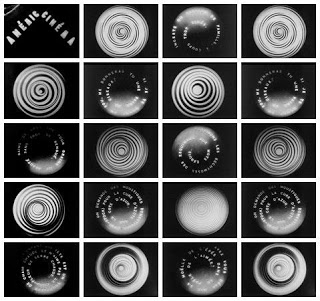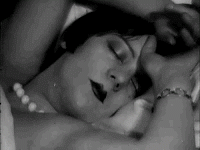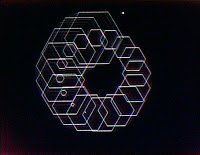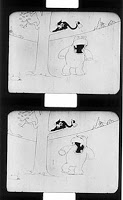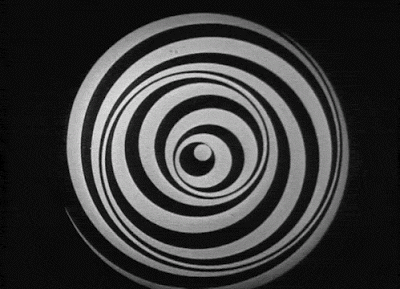
Oddball Films presents Strange Sinema 100, a monthly evening of newly discovered films, rarities and choice selects from the stacks of the archive. Drawing on his collection of over 50,000 16mm film prints, Oddball Films director Stephen Parr has compiled this 100th (!) program of classic, strange, offbeat and unusual films. This 100th program is a celebration of mesmerizing, hypnotic films, designed to push your perceptual boundaries. Strange Sinema 100: Hypnotica features a stunning, genre twisting mix of seminal, awe inspiring films, from trance-inducing visual poems, stunning Czech stop-motion animation and ethnographic rituals to meditative ruminations on higher consciousness. Films feature Man Ray's surrealist classic L'Etoile de Mer (1928) a haunting, dreamlike ode to subconscious sexual desire, Marcel Duchamp’s ground-breaking Anemic Cinema (1926), a hypnotic exploration of wordplay intermixed with optical illusions, John Whitney's Arabesque (1975), the legendary masterpiece of shimmering, oscillating waves set to the music of Persian composer Maroocheher Sadeghi, Michael Whitney's Binary Bit Patterns (1969) a hypnotic psych-folk audiovisual experience that suggests a secret symbiosis between the digital and the organic as various Eastern graphic permutations appear, dissolve and undergo metamorphoses on the screen, Lapis (1965), made by a spiritualized James Whitney with handmade cels evoking a single mandala moving within itself; its particles surge around each other in constant metamorphosis, Tanka (1976) David Lebrun’s remarkable and fierce animated vision of ancient gods and demons in the Tibetan Book of the Dead, Margaret Mead and Gregory Bateson’s legendary ethnographic study Trance and Dance in Bali (1937-39), Glittering Song (1965) true hypnotica-this tantalizing object animation brings to life discarded shards of broken glass, transforming the dangerous trash into a sparkling magical world (a huge hit at our Czech stop-motion show), Spacy (1981) a stunning, unforgettable, hypnotic short by Japanese avant-garde maestro Takashi Ito, Dream of Wild Horses (1962), a remarkable cinematic poem using slow motion and soft focus camera to capture the wild horses of the Camargue District of France as they roam on the beach running through walls of fire and water, plus! The animated Felix Hyps the Hippo (1920s), featuring Felix the Cat hypnotizing a hippopotamus!
Date: Thursday, May 26th, 2016 at 8:00pm
John Whitney‘s Arabesque, is considered by many to be the seminal computer film. Set to the music of Manoochelher Sadeghi, and created during a residency at IBM Whitney balanced science with aesthetics as he experimented with the eccentricities of Islamic architecture creating whirling, exotic flows of computer generated images. Arabesque was one of the first computer generated films that married technology and art is a focused, cinematic manner. Working with his early home-made computerized motion-control set-up, Whitney could produce a variety of innovative designs and metamorphoses of text and still images, which proved very successful in advertising and titling of commercial projects. He also did various commercial assignments including the title design for Hitchcock's feature Vertigo (in association with Saul Bass), and the preparation (in association with Charles Eames) of a seven-screen presentation for the Buckminster Fuller Dome in Moscow.
The spectacular, fast-paced film features quilt-like tapestries of polyhedral and crystalline figures pulsating and multiplying with a kind of universal logic eliciting a hypnotic, trancelike effect from the viewer. This film echoes a preoccupation with the mandala image and the interest in Eastern meditative philosophy that is seen in the work of the whole Whitney family. Employing computer generated imagery with optically introduced color and flicker effects, Michael Whitney creates a hypnotic, psych-folk audiovisual experience that suggests a secret symbiosis between the digital and the organic as various Persian inflected graphic permutations appear, dissolve and undergo metamorphoses on the screen. With original soundscore.
In this M.J. Winkler presentation, Pat Sullivan's cartoon creation Felix the Cat becomes a self-taught hypnotist and, after a series of adventures, uses his magnetic talent to mesmerize a runaway hippopotamus.
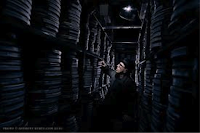
Curator Biography:
Stephen Parr’s programs have explored the erotic underbelly of sex-in-cinema (The Subject is Sex), the offbeat and bizarre (Oddities Beyond Belief), the pervasive effects of propaganda (Historical/Hysterical?) and oddities from his archives (Strange Sinema). He is the director of Oddball Films, a stock film company and the San Francisco Media Archive (www.sfm.org), a non-profit archive that preserves culturally significant films. He is a co-founder of Other Cinema DVD and a member of the Association of Moving Archivists (AMIA) where he is a frequent presenter.
About Oddball Films
Oddball Films is a stock footage company providing offbeat and unusual film footage for feature films like Milk, documentaries like The Black Panthers: Vanguard of the Revolution, Silicon Valley, Kurt Cobain: The Montage of Heck, television programs like Mythbusters, clips for Boing Boing and web projects around the world.
Our screenings are almost exclusively drawn from our collection of over 50,000 16mm prints of animation, commercials, educational films, feature films, movie trailers, medical, industrial military, news out-takes and every genre in between. We’re actively working to present rarely screened genres of cinema as well as avant-garde and ethno-cultural documentaries, which expand the boundaries of cinema. Oddball Films is the largest film archive in Northern California and one of the most unusual private collections in the US. We invite you to join us in our weekly offerings of offbeat cinema.



